Do you have loose skin after pregnancy?
You are not alone.
Saggy belly skin is a common issue, regardless of whether you had a vaginal delivery or a c-section.
In today’s post, you’re going to learn the truth about skin tightening after pregnancy.
Specifically, you’ll learn:
- If it’s possible to tighten loose skin,
- How to prevent loose skin in the first place, and
- What kind of results you can expect to see.
If you’re ready, let’s dive right in.
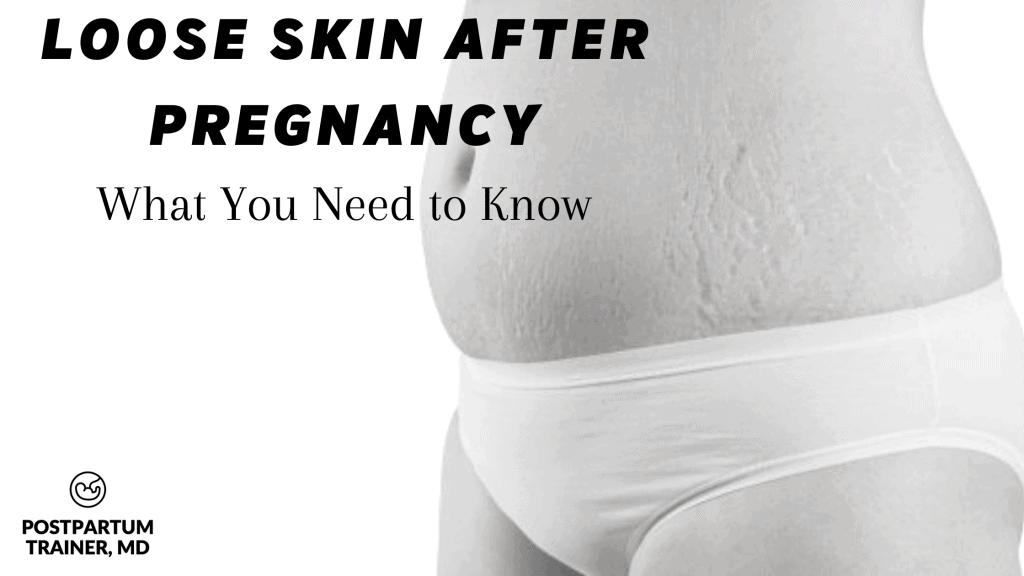
Is It Possible To Tighten Loose Skin?
It depends on how much loose skin you have.
The amount of loose skin you have will depend on how much and how fast you lose weight in the postpartum period. If you experience a massive drop in weight, you will likely have more loose skin than average.
Unfortunately, in some circumstances, the skin may never tighten.
With that said, there are a few things you can try to improve the appearance of loose skin.
I’ll go over those strategies below.
8 Ways To Tighten Loose Skin After Pregnancy (Without Surgery)
So now let’s go over the 8 strategies I have for you.
These 8 things will help you lose body fat, develop some lean muscle, and boost your confidence!
The very first thing you need to do is:
#1 Drink more H2O
Water is the elixir of life. Besides being absolutely necessary for everything you do – water is a simple way to help your skin remain hydrated and elastic.
Have you ever seen someone who is dehydrated?
They have sunken eyes, shriveled skin, and decreased skin turgor. This is medical speak for inelastic skin.
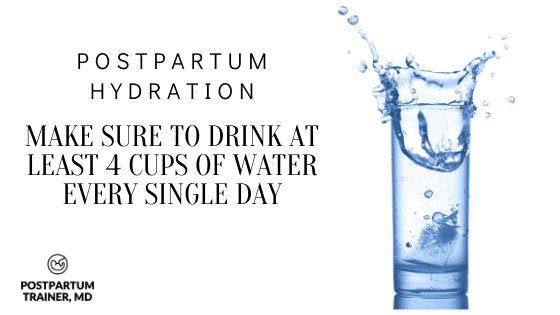
In other words, your skin should have an elastic quality to it- kind of like a rubber band.
When you stretch it, it should go back to its normal shape. When you are dehydrated, the skin simply doesn’t bounce back.
Staying well-hydrated is THE EASIEST way to make sure your skin stays nice and healthy.
How much water should you drink?
I recommend that you drink ~48-64 ounces of water every single day. The nice thing is, you have an easy way to determine how hydrated you are.
The color of your urine!
The goal is for your urine to be pale yellow throughout the day. If it is dark yellow, you are dehydrated and need to drink water!
#2 Eat foods that promote skin elasticity
The second thing that you can do is to eat foods that promote your skin’s elasticity.
Your diet is the best way to provide your body (including your skin) with the nutrients that it needs to be healthy.
If you only eat Pop-tarts and candy all day, you will never give your skin the nutrition it deserves.
The best part is, you don’t have to overhaul your diet.
All you need to do is include nutrient-rich foods into your diet.
The most nutritious foods are fruits and vegetables.
Which ones? It doesn’t matter which ones you eat.
Just eat more of them, as often as you can!
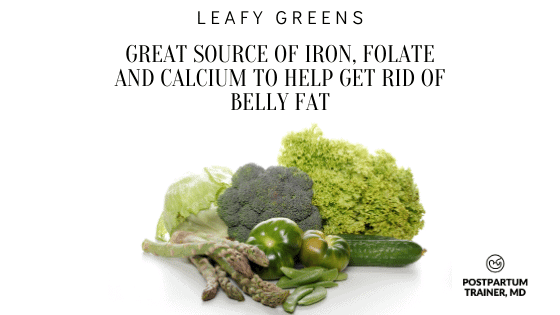
#3 Consume healthy fat and protein
The other dietary component to maintaining healthy skin is to ensure that you are eating healthy fats and protein.
These two macronutrients are absolutely critical for maintaining a healthy internal and external environment in your body.
Healthy fat is important for:
- vitamin absorption
- hormone production
- temperature regulation
- and organ protection
In fact, the most important vitamins for skin health are fat-soluble vitamins.
This means that your body needs healthy fat in order to process them!
I’ll get to those vitamins in just a moment.
What about protein?
Well, protein is the most important nutrient for maintaining and developing lean muscle tissue. Which by the way, is my next tip for you.
#4 Do regular strength training
Exercise is hands down one of the best ways to live your healthiest life. It also happens to be the best way to tone and develop your body.
When you strength train, you are teaching your body how to use your muscle tissue in the most efficient way possible.
This is the only way to build muscle tone while helping you to get rid of fat.
As a result, the lean muscle tissue you develop can help improve the appearance of your skin from underneath.
This is just one of the many benefits of regular strength training.
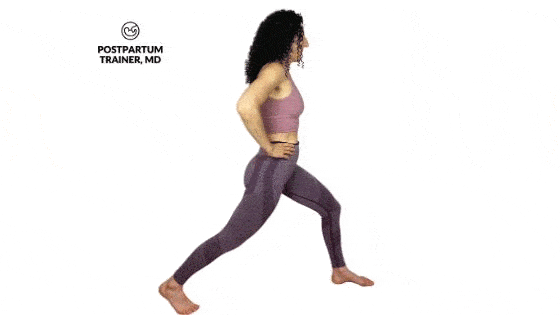
If you want to get started – check out an easy at-home postpartum workout and my simple postpartum kettlebell workout.
—-
These next few tips are to help you lose any excess fat you may be carrying around.
Maintaining a healthy body composition will always have a positive effect on your body in every way.
Here they are.
#5 Stay as active as you can
Aside from maintaining a strength training schedule, you should also try to be as active as possible. This is one of the little-known ways to keep your metabolism high and body fat levels low.
This does not mean you have to go running and/or swimming on a regular basis.
This could be as simple as walking every day. Walking is one of the best and most underutilized forms of exercise.
Whatever days you aren’t exercising, take a 20-minute walk.
This is a great way to maintain a healthy lifestyle!
#6 Breastfeeding can help
Did you know that you breastfeeding is a highly demanding activity for your body?
It’s true.
It’s kind of like nature’s way of helping you restore your body weight back to pre-pregnancy levels. While the overall effect on weight loss is modest – breastfeeding is extremely beneficial to your baby.
The important thing is that you stay well hydrated throughout this time.
I go over this in a lot more detail in my post on How to Lose Weight While Breastfeeding.
#7 Keep your cortisol in check
Cortisol is the stress hormone. It primarily gets released whenever we are in a “fight or flight” situation.
Thankfully, we don’t have to do much fighting or running away from predators these days, but we do experience other forms of stress.
You don’t need any scientific data to prove to you that your body experiences interesting changes whenever you are highly stressed.
We also have direct evidence that high levels of cortisol (as seen in Cushing’s syndrome) can cause a thinning/weakening of the skin.
While it may be difficult to control the amount of stress you experience, you do have control over how you manage it.
And I have one great tip to help you manage.
Sleep!
Sleep is a great way to keep stress hormones in check while refreshing your body and mind.

As simple as this tip is – please do not underestimate the importance of it. Sleep deprivation has been clinically proven to result in high cortisol levels throughout the day.
I know that this is easier said than done.
But try your best to improve the quantity AND/OR the quality of your sleep.
A few things you can try are:
- make your bedroom as dark as you possibly can (unplug everything)
- keep your room cool (you can always use more blankets)
- avoid large meals within 2 hours of your bedtime
- don’t ever use your phone while lying in bed
#8 Try Skin Firming Products
The last thing that I want you to try is skin firming products. There is some research to show that products containing anti-oxidants such as:
- Vitamin C
- Vitamin E
- Vitamin B3
can prevent the degradation of collagen – (one of the important structural proteins in the skin), and improve skin elasticity.
There are plenty of products on the market – just make sure to get one from a reputable brand. I personally use products by Tracie Martyn which I have found to be one of the cleanest, all-natural products.
They aren’t cheap – but you will notice the quality immediately.
I recommend the Face and Body Firming Resculpting Cream to try and improve the elasticity of your skin.
Bonus Tips: Other Things You Can Try
Lastly, here are three other things you can try to help tighten loose skin.
Belly/ Skin wraps
Some women have noted improvement in skin health with the use of belly wraps. This kind of treatment is often used in spas.
I think this is less likely to help your skin health, but it probably won’t harm it either.
Collagen Supplements
Another popular recommendation is to take a collagen supplement. There is some research to show that collagen supplements can help improve skin wrinkles and joint health. In theory, it might help with loose belly skin, but this is yet to be determined.
Always keep in mind that the supplement industry is not regulated by the FDA. Do your research before investing.
Vitamins A, C, E Supplements
Lastly, you could also supplement with Vitamins C and E which are the major antioxidants that protect your skin from oxidative damage.
Vitamin A has also been described to help with skin health.
I prefer that you get your vitamins from food – but supplements could serve as an easy alternative for you.
Last Resort: Surgery
If none of the above have helped you in reducing your loose skin – and this is causing you a lot of distress, then surgery remains an option.
A plastic surgeon could perform an abdominoplasty (aka a tummy tuck) to get rid of loose skin and excess abdominal fat.
This is beyond the scope of this post – but I want to present you with all your options!
Be sure to do your own research before undergoing any surgical procedure.
The 7 Step Loose Skin Daily Checklist
So to summarize the key strategies in this post – I created this little checklist to help guide you on what you can do on a daily basis.
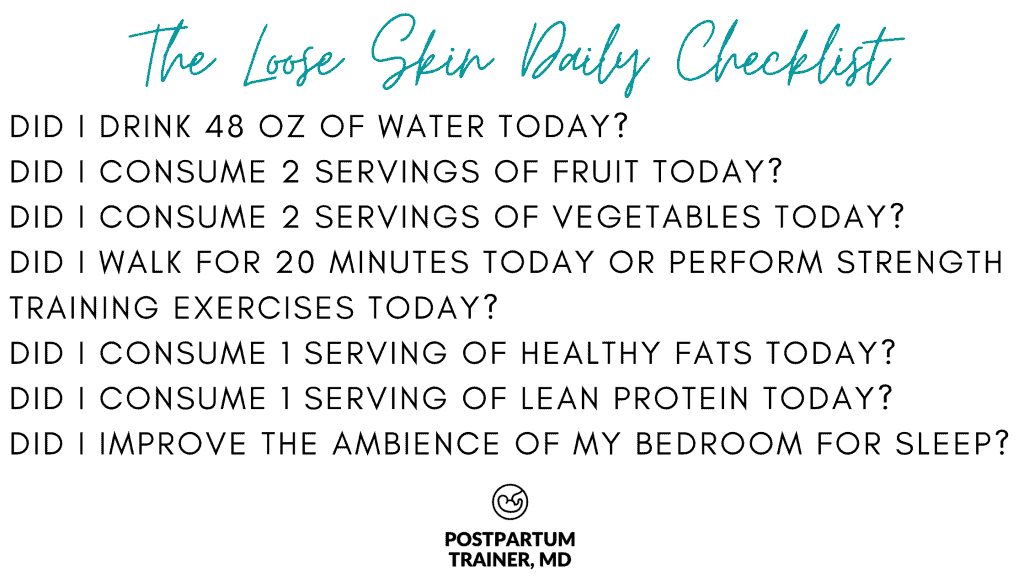
How long does it take for skin to tighten after pregnancy?
If you had a normal BMI at the start of your pregnancy (18-24.9) and gained the recommended 25-35 pounds, you may notice your skin returning back to normal over the next 12 – 16 weeks.
In the majority of cases, your skin cells will retain their ability to bounce back and tighten up on their own. However, if you gained 50 pounds or more during your pregnancy, this process may take longer.
What Causes Loose Skin After Pregnancy?
Your skin is an organ composed of several different proteins.
Two of these proteins are collagen and elastin. As we age, we naturally lose these two proteins, which creates the skin manifestations of aging- which include wrinkling and inelasticity.
But aging isn’t the only thing that can cause loose skin.
Carrying a lot of extra weight can lead to a stretching of the skin, which is often seen in pregnancy. This is especially true if you have a twin gestation or large baby.
Unfortunately, this stretching can damage the natural structure that provides elasticity to the skin. Once your belly goes back to its pre-pregnancy size, you are often left with excess skin that is loose and saggy.
How can I prevent loose skin after pregnancy?
The best prevention strategies for saggy skin postpartum are:
- doing your best to maintain a healthy pregnancy weight, and
- staying very well hydrated.
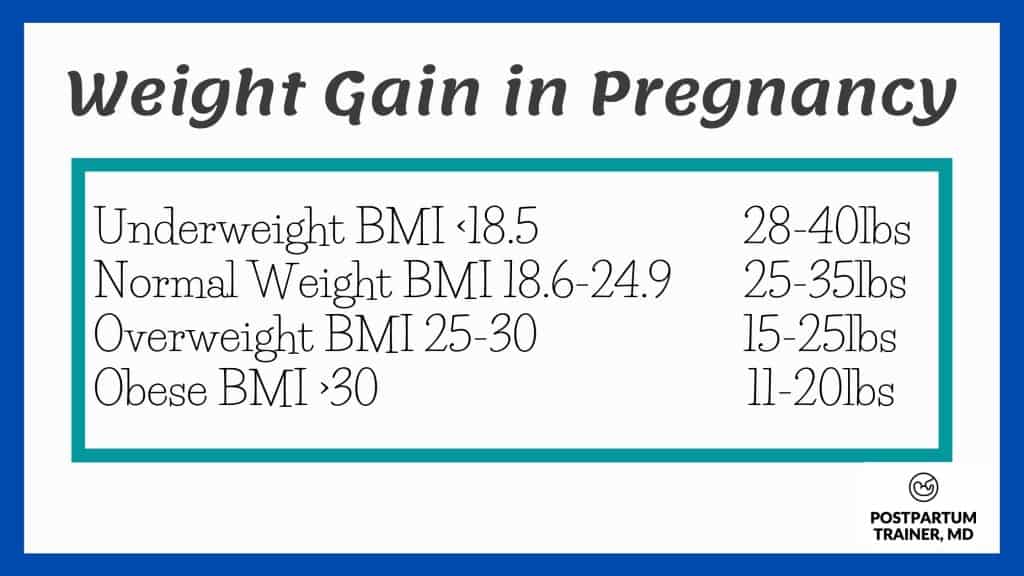
Sticking to the recommended weight gain guidelines of pregnancy will minimize excessive stretching of the skin, which will manifest as stretch marks during pregnancy, and ultimately loose skin postpartum.
The second prevention strategy is to maintain high levels of hydration. As I described earlier, water is your body’s secret weapon to maintaining skin elasticity.
These are the two easiest ways to prevent saggy skin after pregnancy.
Does everyone have loose skin after pregnancy?
It’s hard to give you any exact numbers, but most women will experience some degree of skin changes postpartum.
Some women will be able to get rid of their extra skin naturally, while others will need to follow the tips I have provided for you below.
There’s also a possibility that the strategies above won’t help you lose the loose skin on your belly entirely. Either way, you should do as many of them as you can as they will help you to become the healthiest version of yourself!
What Should I Avoid While Trying To Reduce My Post-Pregnancy Belly Skin?
The number one thing you should avoid while trying to reduce your loose belly skin is crash dieting.
A crash diet is when you make a drastic change to your eating patterns in order to lose weight as quickly as possible.
Common examples of crash diets are: only eating carrots and celery for 30 days, or following a tea and toast diet consisting of 800 calories per day etc.
This is a big no-no!
This type of diet will:
- destroy your metabolism,
- increase the chance of disordered eating (anorexia/bulimia),
- interfere with your happiness and feelings of self worth,
and most of all…
The results are temporary. You will never be able to sustain this type of eating. Once you get out of the crash diet, you will re-gain all, if not, most of the weight, creating a never-ending cycle.
So please, please, please, do not crash diet to try and “speed up your results.”
Instead, check out The Postpartum Trainer’s Nutrition Guide for clinically proven methods of decreasing your body fat percentage.
Other Related Questions
Can massage help tighten the skin on my stomach?
Maybe, maybe not. But it doesn’t hurt to give it a try.
Massage is known for increasing blood flow and circulation in your body – which is always a good thing!
Can I do pilates instead of strength training?
Absolutely. Any type of exercise that keeps you active and moving is better than nothing. If you enjoy pilates and you can stick to it, then do it!
Will strengthening my abdominal muscles help tighten my loose skin?
Unfortunately, doing targeted abdominal exercises will not help you tighten loose skin. You should instead focus on eating a well-balanced & healthy diet while developing more muscle tissue.
With that said, it is still important to develop core strength in the postpartum period. Check out my post on 100 abdominal exercises you can do – even with diastasis recti.
Final Words On Loose Belly Skin After Pregnancy
If you have loose skin after pregnancy, you are not alone.
Although many women experience skin issues postpartum, you can definitely take it upon yourself to do something about it!
It all starts with hydration, having a healthy balanced diet, and developing some muscle tissue!
Now I want to hear from you.
How long did it take for your stomach to go back to its normal size after having a baby?
Did you try any of these tips before with success?
Comment below and let me know!
Related Posts On Health In The Postpartum
- An Easy Postpartum Diet for New Moms
- Getting Fit After Pregnancy: [A Step By Step Guide]
- How To Get Rid of Baby Fat (Everything You Need To Know)
Get Four Free Workouts To Help Strengthen Your Pelvic Floor & Heal Your Mommy Tummy!

Brittany Robles, MD, MPH, CPT
Brittany Robles is a full-time OBGYN physician, a NASM certified trainer, and a prenatal and postnatal fitness specialist. She holds a Master of Public Health degree in maternal health with a special interest in exercise and nutrition. She is also the co-author of The White Coat Trainer. Learn more about her here.
Sharing is Caring – Send This To A Mom In Need!

How do i know if i have loose skin or extra fat? I have the typical mommy tummy overhang but it is softer. Is it skin or fat?
Hi Avani,
Thank you so much for your comment! To determine the difference between extra fat or loose skin you will need to pinch the area. When you pinch your abdomen, if it is thick it is most likely fat. If you pinch the area and its thin, it’s most likely skin. Hopefully that makes sense!
I’ve heard that it can take up to a year for loose skin and belly button shape to go back to normal (or it’s new normal) is that a fair timeline before looking at non-surgical or surgical options?
Hi KC,
Thank you so much for your comment.
One year is a good conservative length of time to try and tighten up loose skin in your abdomen.
With that said you must be honest with yourself and ask:
Did I decrease my body fat percentage?
Have I been consuming nutritious food and avoiding highly processed foods?
Did I stick to an exercise regimen?
If the answer to all those questions is yes, then I think it is fair to look at non-surgical and surgical options!
You said the majority of women’s bodies (who gained the recommended weight and were not too overweight before becoming pregnant) would go back to normal either on their own or with excercise. How much is “majority?” Could you put it into a percentage?